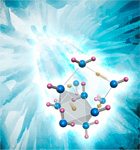 A team led by EFree Chief Scientist Malcolm Guthrie applied neutron technique to Ice VII, a dense form of ice, and made a striking discovery about how ice behaves under high pressure. They obtained the first glimpse of the dissociation of water molecules under unprecedented pressure of over 50 GPa (500,000 times atmospheric pressure). Observation of the breakup of water molecules has been difficult and only partly accomplished with spectroscopic analyses, done also at Carnegie, dating back almost 30 years. Specially designed diamond anvil cells and samples subjected to intense radiation flux at the dedicated high-pressure diffraction instrument SNAP at the Spallation Neutron Source (SNS), Oak Ridge National Laboratory (ORNL) created a picture of the structure and bonding of dense ice different from results of previous theoretical work.
A team led by EFree Chief Scientist Malcolm Guthrie applied neutron technique to Ice VII, a dense form of ice, and made a striking discovery about how ice behaves under high pressure. They obtained the first glimpse of the dissociation of water molecules under unprecedented pressure of over 50 GPa (500,000 times atmospheric pressure). Observation of the breakup of water molecules has been difficult and only partly accomplished with spectroscopic analyses, done also at Carnegie, dating back almost 30 years. Specially designed diamond anvil cells and samples subjected to intense radiation flux at the dedicated high-pressure diffraction instrument SNAP at the Spallation Neutron Source (SNS), Oak Ridge National Laboratory (ORNL) created a picture of the structure and bonding of dense ice different from results of previous theoretical work.Collaborators at Carnegie and Oak Ridge National Laboratory developed new techniques resulting in data that painted an altogether new picture of ice. Not only do the results have broad consequences for understanding bonding in H2http://www.pnas.org/content/early/2013/06/11/1309277110.abstractO, the observations may also support a previously proposed theory that the protons in ice in planetary interiors can be mobile even while the ice remains solid. Being able to ‘see’ hydrogen with neutrons is not just important for studies of ice. The applications of this technical braekthrough could extend to systems that are critical to societal challenges, such as energy. For example, the technique can yield greater understanding of methane-containing clathrate hydrates and even hydrogen storage materials that could one day power automobiles [M. Guthrie et al., Proc. Nat. Acad. Sci. 110, 10552-10556 (2013)].
Figure Caption: A fragment of the crystal structure of the new ice is shown; the oxygen atoms are blue and the molecular hydrogen atoms are pink. Hydrogen atoms that have been pulled off the water molecules are gold. These appear to be located in polyhedral voids in the oxygen lattice (one of which is shaded light grey). Previously, these voids were believed to remain even after the water molecule breaks up at enormous pressures. Image is provided courtesy of Oak Ridge National Laboratory.
